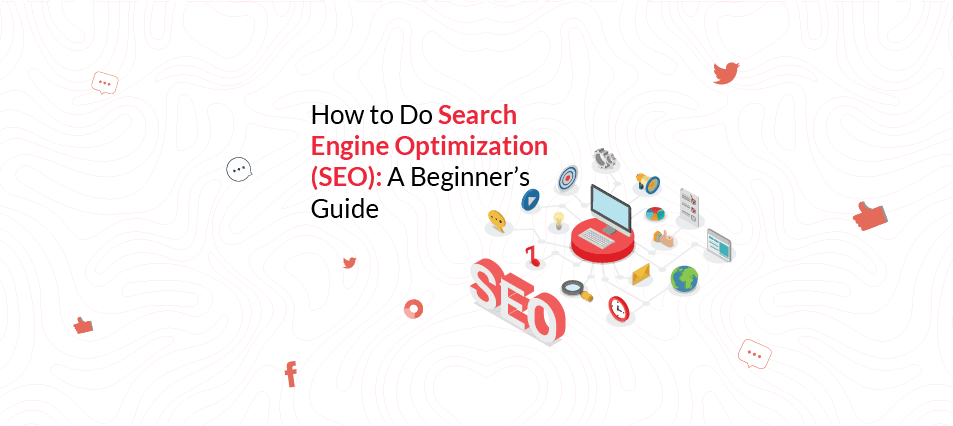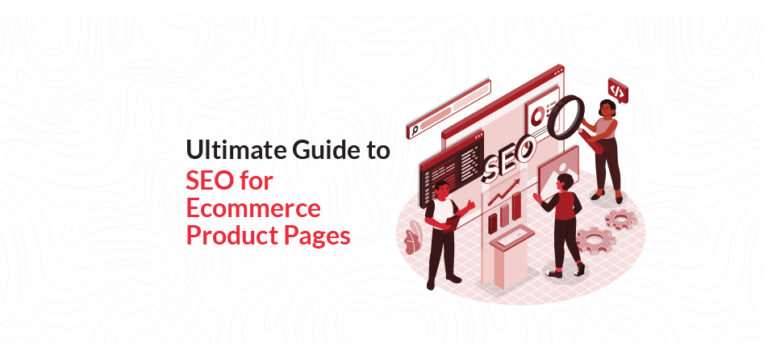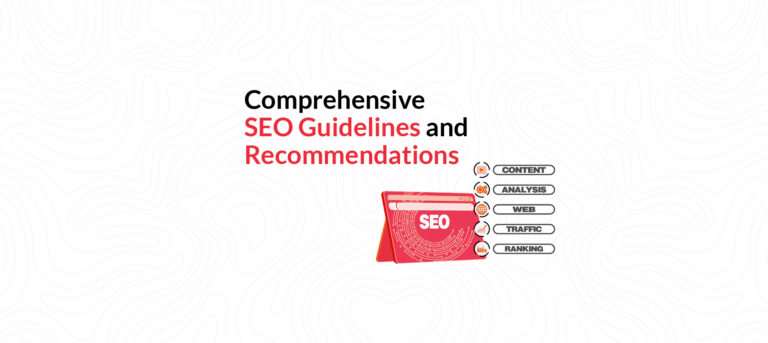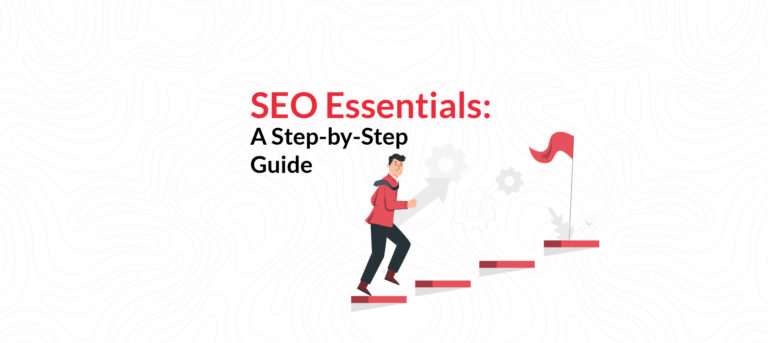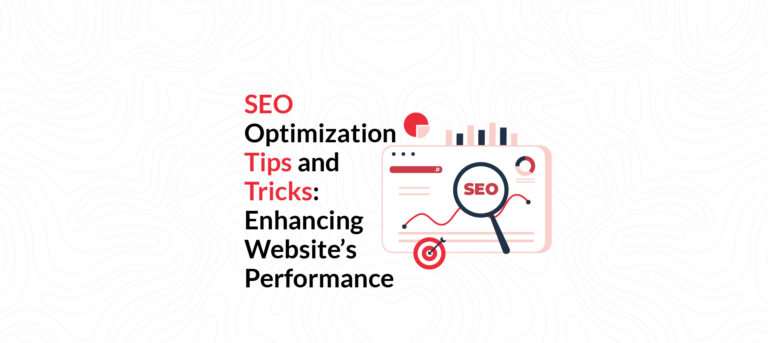A Beginner’s Guide to Understanding Search Engine Optimization
Do you want people to find your website through Google? You need to understand the basics of SEO optimization to ensure success online. Using SEO basics alone can transform your business.
SEO refers to optimizing a website to put it in the best standing of being easily found on the SERP. It translates to more of your site being seen by an audience without having to pay for advertising or paid traffic.
SEO is important because it enables a website to reach its audience of users searching for information, goods, or services that the site offers. How do you do search engine optimization? When you optimize your website, you’re making it easy for the search engines to comprehend and place your site high on the list.
Having knowledge of this SEO for beginners has the potential to determine the performance of the website and its usability. Here, you will find a detailed introduction to SEO and clear instructions on improving your site without prior knowledge.
While it might sound like a magic trick, SEO does not have to be complicated. It helps you provide ample content and a great user experience. Let us help you understand the SEO basics for beginners to ensure online success.
What are SEO basics?
SEO or Search Engine Optimization is a leading digital marketing strategy that leverages non-paid techniques to improve the visibility of your website on search engines like Google, Bing, and Yahoo.
SEO makes your website more visible on Search engine result pages (SERPs). The greater you make the ranking of your site, the higher your chances of getting organic traffic. Several components comprise SEO: Keywords, content, on-page SEO, off-page SEO, technical SEO, and UX.
Keywords refer to the words typed by users in the search bar to find content on the internet. Keyword research and use are critical to achieving a good rank. The content should, therefore, be of high quality, and it has to be more of what the visitor wants to see. On-page SEO can be defined as optimizing every page in a site to rank higher, including the meta tags, headers, and images alt text.
Off-page SEO is made of processes outside your website, like backlinking. Technical SEO entails enhancing the functionality of your site, including its functionality in terms of speed, mobility, and structure.
As you improve search engine rankings, you can drive more traffic to your website, leading to more sales and revenue. Unlike search ads, which allow businesses to obtain higher rankings in paid search results, SEO fundamentals allow your site to appear higher in organic search results.

Image Source : Google Analytics
How Search Engines Work?
Keywords can be defined as terms or phrases that users enter into search engines to come across relevant information. Leading search engines like Google strive to deliver the most relevant information to users depending on the set of keywords they enter into the search engine.
How does the search engine decide which result to show?
It features a complex algorithm, taking into account several ranking factors. All of these ranking factors work together to determine the most relevant and useful results. Typically, Google makes use of a step-by-step process to identify and rank web pages, including:
- Crawling
- Indexing
- Ranking
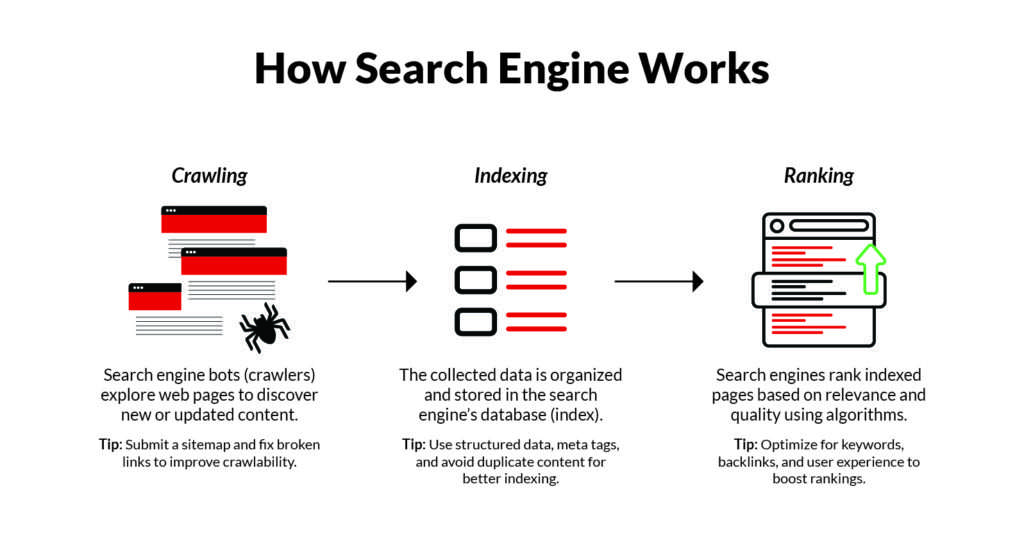
The Importance of SEO for Beginners
For both beginners and seasoned website owners alike, SEO is crucial for the following reasons:
- Driving more organic traffic to your website
- Increasing your brand awareness
- Improving user experience
Basic SEO Optimization for Beginners
SEO marketing is an important strategy that is used to improve the visibility of the website in the SERPs or Search Engine Results Pages. SEO marketing is concerned with optimizing different aspects of the website to boost its ranking and gain more organic traffic from leading search engines.
How to do seo for a website to effectively optimize your website, follow these key steps: keyword research, on-page SEO, quality content production, site speed, mobile-responsive websites, backlinks acquisition, image optimization, and internal linking.
Keyword research to discover keywords that persons intending to visit the site may use. Improve on-site factors by including the keywords in the title, headers, and others spread within the text. Develop compelling content that is insightful, pertinent, and informative. Complement your content from time to time with fresh material.
Optimise site speed by reducing the number of images used and enabling the browser to cache some code. Making your website friendly to mobile devices is crucial as more people use these devices to access the internet. Drive traffic to your site through premium backlinks from reliable sites to enhance your site’s credibility. Images should also be optimized with alt tags and compression to enhance their loading time and usability in case of a disability. Employ internal linking to distribute link equity and enhance the site’s navigation system.
Some of the crucial components of SEO marketing are:
- On-Page SEO: Concerned with strategies used directly on the website to improve its rankings. This can include updating the existing content or changing title tags or meta-descriptions. When keywords are used effectively, they can produce top-quality content.
- Off-Page SEO: Concerned with activities outside the website to improve rankings across the SERPs. Link building is an important off-page SEO strategy, ensuring authoritative websites link back to your website.
- Technical SEO: Concerned with the backend structure of the website. The process involves optimizing the backend of the website, such as improving website speed and mobile-friendliness.
SEO Marketing for Beginners: Strategies to Get Started
Content Marketing
Submit blog entries on various subjects within a set frequency to reach your target audience. Enable video so that the users stay on the site longer. Design a beautiful infographic to pass on information in a simple way and to get more backlinks.
Social Media Marketing
Social media can be optimized for SEO by using relevant keywords in profile descriptions, post captions, and hashtags. Creating high-quality, engaging content that encourages sharing and backlinks is also crucial. Utilizing social media analytics to track performance and adjust strategies accordingly can further enhance SEO efforts.
Local SEO
Google Business Profile listing should be established and optimized correctly. Search for local keywords to implement in your content to target customers in that specific area. Promote businesses to encourage loyal and happy customers to leave positive reviews on Google and other relevant review sites.
Analytics and Monitoring
Make use of Google Analytics tools to track the website. Use the Google Search Console to track your site’s ranking on the search engine results page. It’s important to conduct SEO audits frequently to determine areas that require rectification. Compare your SEO strategy against the analytics data and industry trends and make necessary changes and adjustments.
SEO step by step : Beginner’s Guide
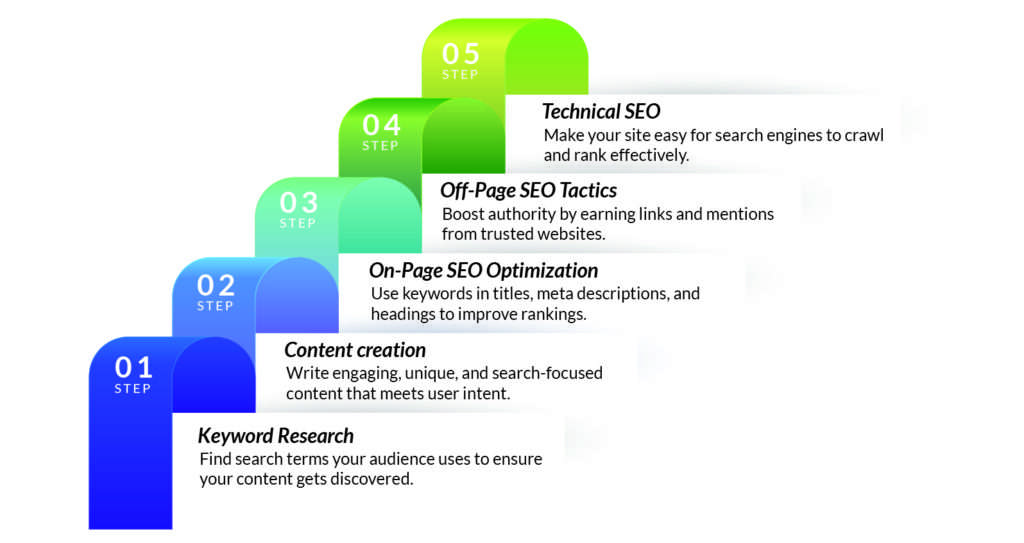
Step 1: Keyword Research
Keyword research is defined as the process of identifying relevant search queries that your target customers might type into search engines to come across products, services, or information.
Keywords are referred to as the foundation of SEO. When you create a page on a specific topic that no one might be searching for, the page will not receive any traffic from the search engine. Keyword research helps you make sure that there is a specific search demand for different topics you wish to cover. Therefore, when your page ranks well on the search engine for the target keyword, you will receive a consistent stream of visitors on the same.
In this context, feel free to use Google’s Keyword Planner, Ahrefs, and SEMrush, among other keyword research instruments. Look at which keywords your competitors are targeting to determine which ones you can take action on. This is where you should begin targeting long-tail keywords that are less saturated than general keywords.
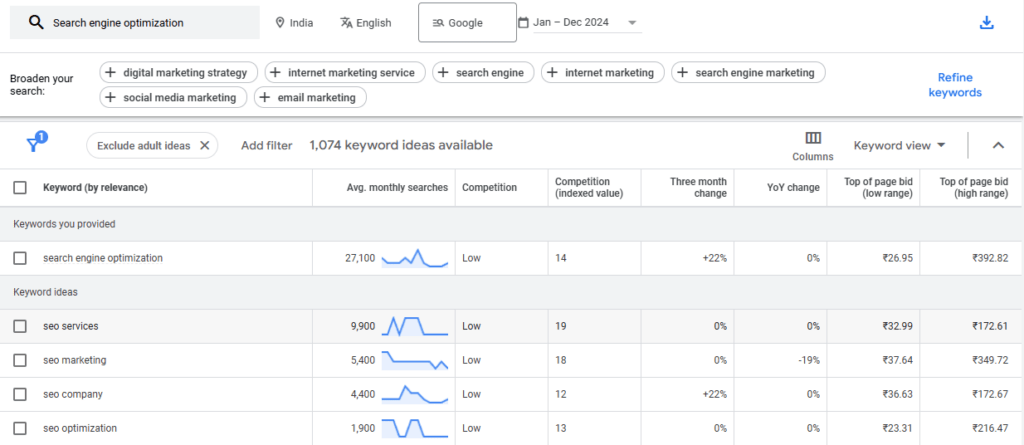
Image Source : Google Keyword Planner
Step 2: Content Creation
SEO content is defined as content designed to rank effectively on search engines. It could refer to a blog post, a landing page, or anything else. Not all content will rank well or get ample traffic from organic searches.
Creating SEO-friendly content is concerned with providing searchers with what they are looking for and making it eye-catching. When you are able to share unique insights and expertise over all other components, your content will rank higher.
Memorize the reason for the occurrence of the search and make sure your textual content meets these expectations. In general, longer content is more effective because readers spend more time on it, and it has a better chance of ranking higher in search results. It is also advisable not to provide the exact content twice, which could lead to penalties from search engines.
Step 3: On-Page SEO Optimization
On-page SEO is defined as the process of optimizing website pages and blog posts to improve the respective search rankings. On-page SEO is important as even small changes to the page can have a major impact on the overall traffic and rankings.
Be sure to place the Primary Keyword within the title tag. Generate catchy meta descriptions for your articles, including keywords, to increase click-through rates. Using headings, H1 for titles, and H2 or H3 for subtitles is recommended if your content follows any structure.
Step 4: Off-Page SEO Tactics
Off-page SEO is concerned with improving the search engine visibility of the website without performing major changes on the website. This can involve executing activities that will help you earn links and mentions from other authoritative websites.

Image Source : Ahref
Step 5: Technical SEO
Technical SEO is one of the most important aspects of SEO. Web pages are expected to be ready for crawling and indexing to ensure proper rankings.
Technical SEO is concerned with optimizing the website to help search engines identify, crawl, evaluate, and index your web pages. It improves visibility and rankings in search engines.
SEO Marketing for Beginners: Essential Strategies to Master
SEO is the practice of optimizing your website to rank higher in search engine results pages (SERPs). This involves a variety of techniques, including keyword research, on-page optimization, and off-page optimization. By mastering these strategies, you can improve your website’s visibility and attract more organic traffic.
Content Optimization
Content is king when it comes to SEO. High-quality, relevant content is what search engines and users are looking for. To optimize your content, focus on creating informative, engaging, and keyword-rich content that meets the needs of your target audience.
Mobile Optimization and Site Speed
In today’s mobile-first world, mobile optimization is essential for SEO success. Ensure your website is responsive and loads quickly on all devices. Google prioritizes mobile-friendly websites in its search rankings.
User Experience (UX) and SEO
User experience (UX) plays a significant role in SEO. Search engines prioritize websites that offer a positive user experience. Focus on creating a website that is easy to navigate, visually appealing, and user-friendly.
Common SEO Mistakes to Avoid for Beginners
Some common SEO mistakes to avoid as a beginner are:
- Not paying attention to mobile optimization
- Neglecting local SEO
- Keyword stuffing
- Creating duplicate content
- Using the wrong keywords
- Not paying attention to title tags and meta-descriptions
- Not updating content
- Improper link building practices
Tools and Resources to Enhance Your SEO Efforts
The use of the right tools and resources can boost your SEO efforts, whether you are a beginner or a seasoned marketer. Some essential tools, both paid and free, that can help you optimize your website are:
Conclusion
Understanding the fundamentals of SEO is essential for businesses of all sizes to improve their online visibility and attract organic traffic. By optimizing your website’s content, content structure, and technical aspects, you can enhance your search engine rankings and drive more potential customers to your business.
By consistently implementing SEO best practices, you can build a strong online presence and achieve long-term success in the digital age.
SEO is a skill that one develops over time, and one must keep learning as keywords and algorithms form. With knowledge of what SEO is and its core components, such as keyword research and optimization, creation of high-quality content, on and off-page optimization, and technical optimization, you’ll be able to boost your website rankings and gain more organic traffic. SEO is not a one-time activity but an ongoing process that changes with changes in the search engine algorithm and user preferences.
Constantly benchmark your online presence’s efficiency with tools like GA and GSC to see what has room for enhancement. It is crucial to keep up with the SEO trends and treatments to keep on improving on the rankings so achieved. When using these SEO tips as a guide, you will help increase the ranking of your site on search engine results pages while giving users a more helpful online experience resulting in greater interaction with your site and its content.
Get an Ad-Free Revenue with O+
SEO requires a consistent and tailored effort which is where O+ comes into play. We understand the technical nuances that factor into the organic growth patterns. With an experimental approach, our team constantly implements, analyses and re-implements strategies to assure your business scales sustainability and provides long-term benefits. We will take your brand ad-free on autopilot where lead generation will be streamlined and organic conversations will be the primary source of ROI from your website. As the best SEO company in India, we are dedicated to enhancing your brand’s online presence and achieving measurable results.

